In this article, You will read the Growth and development, Locational factors, and distribution of the Iron and Steel industry in India – for UPSC IAS (Industry – Geography of India).
Iron and Steel industry
Modern industrialization is synonymous with the development of the iron and steel industry. The extent of industrialization in any country is usually measured in terms of the per capita consumption of steel. This is because all other industries have to depend on steel out of which machinery of any kind is manufactured.
As soon as the process of machine production gets momentum, the rate of industrialization gets strengthened. Thus, in the dynamics of industrial growth in any country, the growth of the iron and steel industry is undoubtedly crucial.
India surpassed Japan as the second top steel producer in January 2019. India was the world’s second-largest steel producer with production standing at 111.2 million tonnes (MT) in 2019.
In FY21, the production of crude steel and finished steel stood a 102.49 MT and 94.66 MT, respectively. According to CARE Ratings, crude steel production is expected to reach 112-114 MT (million tonnes), an increase of 8-9% YoY in FY22. The consumption of finished steel stood at 93.43 MT in FY21.
Exports and imports of finished steel stood at 10.79 MT and 4.75 MT, respectively, in FY21. In April 2021, India’s export rose by 121.6% YoY, compared with 2020. In FY20, India exported 8.24 MT of finished steel.
The growth in the Indian steel sector has been driven by the domestic availability of raw materials such as iron ore and cost-effective labour. Consequently, the steel sector has been a major contributor to India’s manufacturing output.
The Indian steel industry is modern with state-of-the-art steel mills. It has always strived for continuous modernization of older plants and up-gradation to higher energy efficiency levels.
Significance of iron & steel industry
- It is the index of modernity, the development of the steel industry has a direct link with the development of a country.
- Iron and steel industry act as a backbone for the physical infrastructure development of the country
- Iron and steel industry provides strong forward-backward linkage for the industrial infrastructure of a country.
- Iron and steel industry is important for the regional development of the place where these industries are located.
- Iron and steel industry plays a major role in the development of many other industries like the automobile industry.
- Iron and steel industry has generated huge employment especially in backward areas where these industries are located.
- Iron and steel industry gave boosts to the transportation sector like road, railway, airway, and waterways.
- Iron and steel industry is important for the growth of the research and development sector in India.
Growth and development of the Iron and Steel industry
- Indians are known for the art of smelting iron in early times e.g. Mehrauli pillar. But first Iron and steel industry unit on modern lines was set up in 1830 at Porto-Nova (Tamil Nadu) but was not successful. Other attempts in the second half of the 19th century met the same fate.
- The real beginning of Iron and steel industry was in 1907 with setting up of TISCO plant at Jamshedpur. It was set up in the confluence of Subarnarekha and Kharkai rivers in 1907. Since then, Indian iron and steel industry made a great stride to reach its present stage.
- The Indian Iron and Steel Company (IISCO) were set up in 1919 at Burnpur followed by the setting up of Mysore Steel Works at Bhadravati (now Visveswaraya Iron and Steel Works) in 1923.
Rapid growth after independence
- The development of Iron and Steel industry was envisaged during first five year plan (FYP), but it was during second FYP that three integrated projects were started at Bhilai (with erstwhile USSR technical and financial support), Rourkela (with Germany assistance) and Durgapur (with U.K assistance)
- During third FYP, Bokaro steel plant was started (production started in 1972)
- Three more Steel plants planned during fourth FYP was started to meet the requirement of steel. These plants were:
- Salem Iron and Steel Plant in Tamil Nadu
- Vizag Iron and Steel Plant in Andhra Pradesh
- Vijayanagar Iron and Steel Plant (Hospet district in Karnataka)
- Steel Authority of India (SAIL) Established in 1973, SAIL is a government undertaking and is responsible for the management of steel plants at Bhilai, Durgapur, Rourkela, Bokaro and Bumpur and also the Alloy Steel Plant at Durgapur and Salem Steel Plant.
- The management of Indian Iron and Steel was taken over by Government on 14th July, 1976. Visweswaraya Iron and Steel Limited were also taken over by SAIL in August 1989.
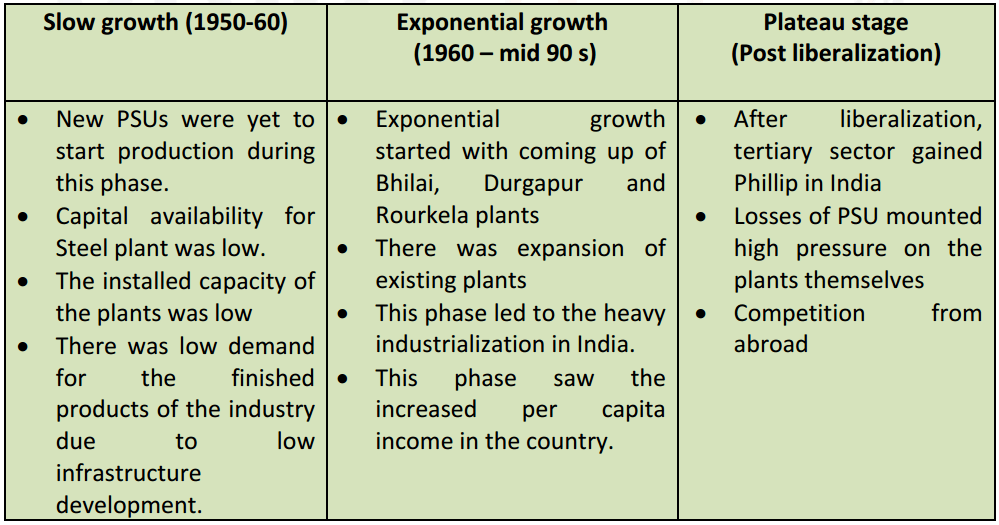
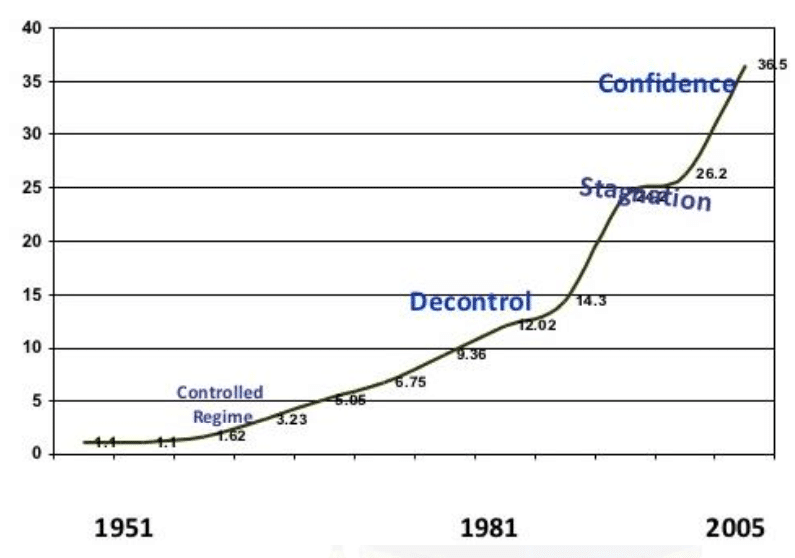
Location factors of the iron and steel industry
- Iron and steel industry uses large quantities of heavy and weight losing raw materials and its localization is primarily controlled by the availability of raw materials. However, other factors do play role in the location of the Iron and steel industry which are discussed below:
- Raw material
- Iron and Steel industry uses a large quantity of heavy and weight losing raw material, so its location is primarily guided by the availability of raw material.
- Most of the iron and steel plants of India such as Jamshedpur, Burnpur, Durgapur, Rourkela, Bhilai, and Bokaro are located in Jharkhand, West Bengal, Orissa and Chhattisgarh. These states are very rich in coal and iron ore deposits and are important producers of these materials.
- Visveswaraya Iron and Steel Works at Bhadravati is a major exception which is located far away from the main coal-producing areas of the country. Earlier, this centre was depending upon charcoal which was available locally. Now it uses hydroelectricity from the Sharavati Power Project.
- The other raw materials used in this industry are manganese, limestone, dolomite, chromite, silica, etc. These raw materials are used in small quantities and can be transported without much difficulty. Hence, they do not materially affect the localization of this industry.
- Market
- Another important factor influencing the localization of the iron and steel industry is the availability of market. Steel products of an integrated steel plant are quite bulky and it has been estimated that the transport cost per tonne-kilometer of steel product is about three times more than that of coal or iron ore.
- Thus, following the theory of minimum transportation cost many centres of iron and steel production tend to be attracted by the market.
- One of the major consumers of the steel industry is the automobile industry which in itself prefers a market location. These industries have also raised the importance of the market for the iron and steel industry.
- About half of the metal now melted in the world’s iron and steel furnaces is scrap. Industrialized areas, especially with steel-consuming industries, are the major sources of scrap iron. Thus, the market has a double attraction, as the consumer of steel and as a source of raw materials. However, the use of scrap as raw material on a large scale is yet to pick up in India.
- Transportation
- Both raw material & finished products are bulky and require big transportation facilities.
- Optimum transportation cost of carrying raw material from source and finished products to market play important role in the location of Iron and Steel Industry.
- However, setting up of large integrated steel plant boosted the growth of infrastructure, especially road and rail in these regions.
- Technology
- With the increasing popularity of the open-hearth processes, scrap has become a very important raw material in this industry.
- This process uses scraps as raw material (1/3 of the world’s raw material). It is easier to transport in raw form.
- Recent technological developments in transport, the use of scrap as raw material and the agglomeration economics have made market-oriented location more advantageous than ever before.
- Port location
- Port location provides easy and cheap means of transportation. These are highly helpful in the import of raw materials and export of the finished products. When some of the basic raw materials need to be imported or the finished Steel is to be exported, seaport locations are preferred.
- The port locations have the additional advantage of easy and cheap means of transportations, i.e. Vizag Steel plant is an important example of this kind of location.
- Government policy
- The ultimate responsibility of balanced regional development rests with the government and in view of this Government has invested heavily in backward areas for developing these industries for example in Jharkhand, Orissa, Chhattisgarh, etc. So this approach was in accordance with the principle of the Trickle-down theory of Growth Pole and Growth Centre.
- At times political lobbying, political opposition, and strategic requirements also greatly influence its location. For example, VISW (Bhadaravati) was set up to fulfill defense requirements.
- Labour
- Cheap and abundant labour is required for this industry. Therefore West Bengal and the nearby regions provide favorable locations for Industrial locations for the Iron and Steel Industry.
| PLANT | IRON ORE | COAL | HEP/WATER | REMARKS |
| TISCO | Gurumahisani (Orissa) Noamundi (Jharkhand) Singhbhum | Jharia, Raniganj | Subarnrekha River | Calcutta port NHS, NH6 |
| IISCO | Guna (Jharkhand), Singhbhum | Jharia | DVC, Damoder River | Calcutta port, NH2 |
| VISW | Kemmangundi (Chikmaglur, Karnataka) | Sharavati power, Bhadra river | Mangalore port NH4 | |
| BHILAI | Daili Rajhara | Korba Kargali | Korba Thermal power plant, Mahanadi Basin | Calcutta-Nagpur Rail, NH6 |
| ROURKELA | Sundargarh, Keonjhar | Jharia Talchar | Hirukud HEP, Sankh-south koal river | Calcutta-Nagpur Rail, NH6 |
| DURGAPUR | Mayurbhanj | Jharia, Ranigan | DVC, Damodar river | Calcutta port, Calcutta Asansol Rail, NH2 |
| SALEM | Local | —— | Mettur dam | Puducherry Coimbatore by NHs export stainless steel |
| VIZAG | Bailadila (Chattisgarh) | Imported + Damodar | ——- | Second largest producer, NH5 |
| VIJAYNAGAR | Nearby | Sringereni | Tungabhadra dam | |
| BOKARO | Kiriburu (Orissa) (Keonjhar) | Jharia | DVC, Bokaro & Damodar rivers | Largest I&S plant, Calcutta port connected through NH2 |
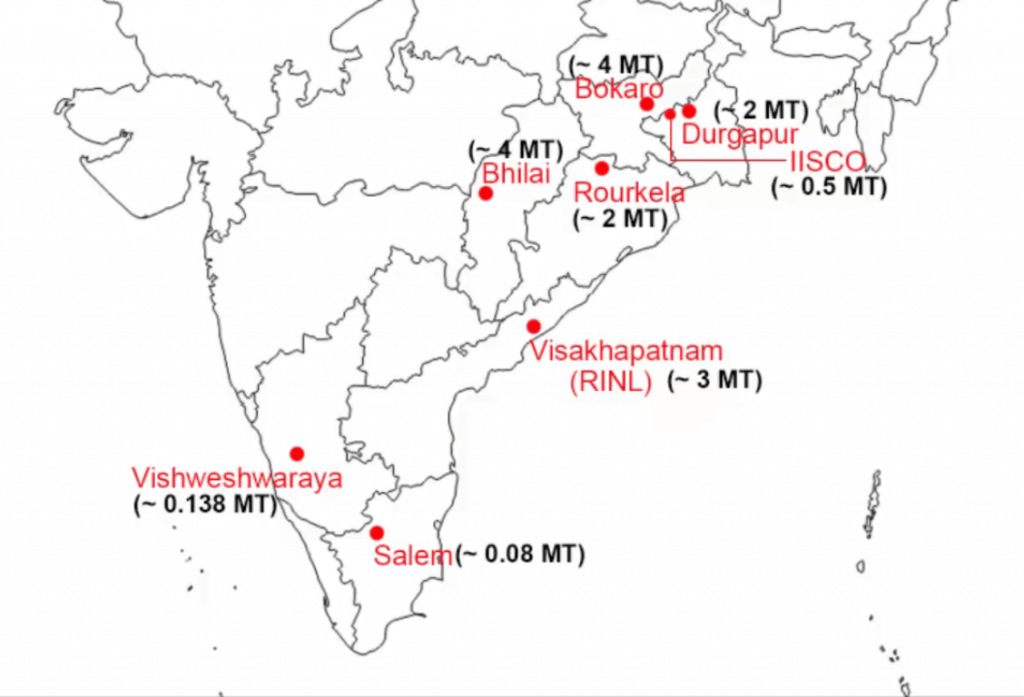
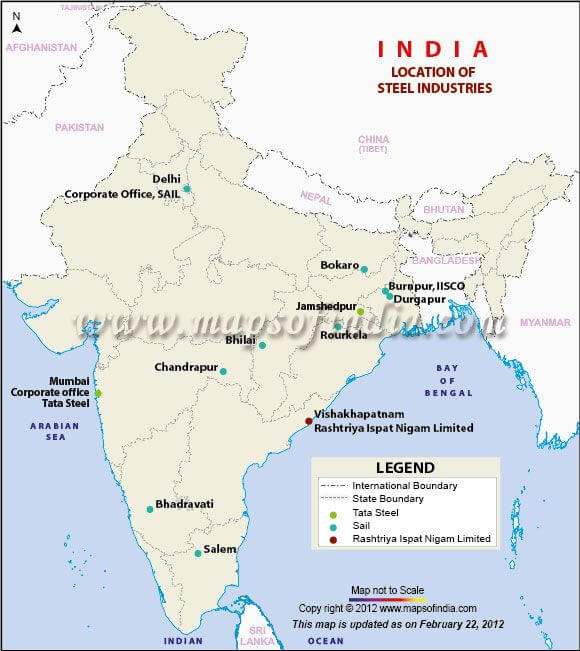
Major Steel Plants of India
TISCO Jamshedpur
- This is the oldest Iron and Steel centre of India. It is a private-sector enterprise. It was established in 1907 by Jamshedji Tata at Sakchi in the Singhbhum district of Jharkhand. Later on, it was renamed as Jamshedpur after Jamshedji. It started producing pig iron in 1911 and steel in 1912.
- Raw material is the most important determinant for the location of the TISCO plant in Jamshedpur. Besides, the later development of transportation, easy availability of labour and facilities of nearby Calcutta port along with the availability of market helped this plant to grow.
- Currently it produces about 3 million tonnes of saleable steel. Following facilities are available to this centre:
- Haematite Iron Ore: High-grade haematite iron ore is available from Noamundi mines of Singhbhum in Jharkhand and Gurumahisani mines of Mayurbhanj in Orissa. These mines are located at a distance of 75-100 km from Jamshedpur..
- Coal: Coal is available from Jharia (Jharkhand) and Raniganj (West Bengal) coal mines located 160 to 200 km from Jamshedpur.
- Manganese: Manganese comes from Joda mines of Keonjhar district in Orissa.
- Kolkata: Kolkata, located at a distance of 250 km, provides port facilities and its industrialized hinterland provides a market for the products.
- Water: Sufficient water for cooling purposes is obtained from Subarnarekha River. In addition to this, the storage dam on Kharkai River also provides water.
- Labour: Densely populated regions of Jharkhand, Bihar, and Orissa provide cheap labour. Major part of labour is drawn from tribal areas of the Chotanagpur plateau.
- Good transport facilities: Jamshedpur is well connected with Kolkata, Mumbai, and Chennai by road and rail and enjoys good transport facilities. NH6 (Mumbai – Kolkata) passes near to it (part of a golden quadrilateral).
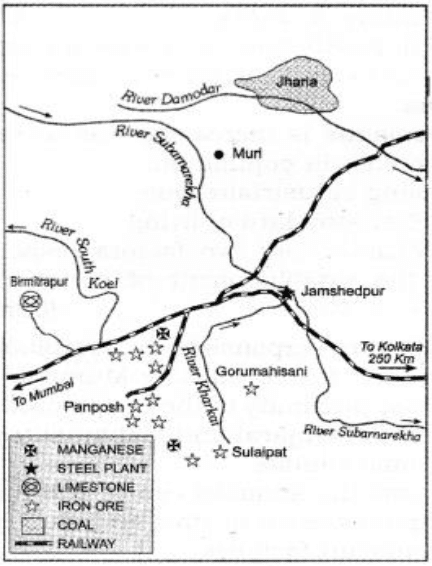
IISCO Kulti, Hirapur and Burnpur
- Three plants at Hirapur (pig iron), Kulti (steel), and Burnpur (rolling) in West Bengal were set up in 1864, 1908, and 1937 respectively. These plants have been merged together and are known as Indian Iron and Steel Company (IISCO).
- It was brought under government control and management in July 1972. The three plants are linked by the Kolkata-Asansol railway line. Hirapur plant produces pig iron which is sent to Kulti for making steel. The rolling mills are located at Burnpur. IISCO enjoys the following advantages
- Iron ore: Iron ore is available from Guna mines in Singhbhum district of Jharkhand located at a distance of 285 km. Some iron ore is also obtained from the Mayurbhanj area of Orissa.
- Dolomite and limestone are obtained from the Sundargarh district of Orissa which is 327 km away. Limestone is also available from the Gangpur and Paraghat areas of Orissa.
- Coal/Power: It used to receive coal from Jharia, located at a distance of 137 km but now the power from the Damodar Valley Corporation is extensively used.
- Kolkata port: It is 200 km Hirapur, Kolkata provides port as well as market facilities for IISCO products
- Cheap labour is available from west Bengal and adjoining areas.
- Road links with Kolkata port and other major destinations through NHs provide good transportation facilities.
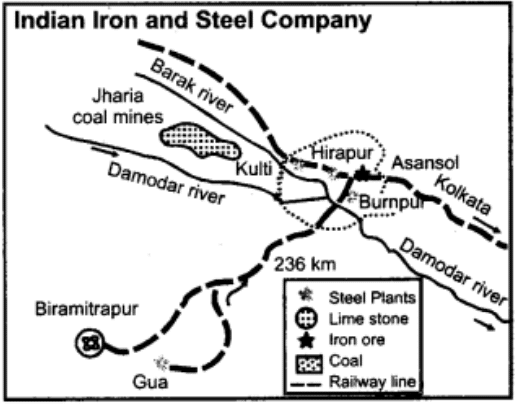
The Visveswaraya Iron and Steel Plant, Bhadravati
- It was established as Mysore Iron and Steel Company (MISCO) in 1923 by the erstwhile state of Mysore. It is located at Bhadravati on the banks of river Bhadravati in Shimoga district of Karnataka
- This plant was brought under state control in 1962 and was renamed as Visveswaraya Iron and Steel Ltd. after the name of great engineer Dr. Visveswaraya. This plant has got a capacity of 1.38 lakh tonnes of steel. There are plans to raise its capacity to two lakh tonnes. This centre enjoys the following advantages.
- High-grade haematite iron ore is brought from Kemmangundi mines in Chikmaglur which is just 40 km away.
- Coal not available in the vicinity, at the time of the setting up of the plant in 1923 the charcoal obtained from the forest wood was used for smelting because coal was not available. Now it uses hydroelectric power obtained from Sharavati Power Project.
- Shimoga and Chitradurga supply manganese. These areas are just 50 km away.
- The Visveswaraya Iron and Steel Plant is well connected to Mangalore port. NH4 (part of a golden quadrilateral) passes near to it.
- The Visveswaraya Iron and Steel Plant is engaged in producing steel for defense purposes.
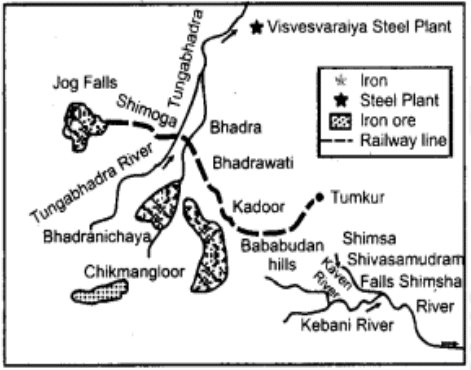
Bhilai Steel Plant
- Bhilai iron and steel centre was set up in Durg district of Chhattisgarh in 1957 with the technical and financial support of the then Soviet Union. Durg happens to be a backward area. The purpose of setting up this plant was to bring prosperity to this area.
- It started production in 1959. Its initial capacity was 10 lakh tonnes which have been raised to 52 lakh tonnes.
- This plant produced 41.87 lakh tonnes of crude steel, 38.32 lakh tonnes of saleable steel and 2.43 lakh tonnes of pig iron in 1996- 97. It enjoys following geographical advantages:
- It procures rich haematite iron ore from the Dalli-Rajhara range which is 80 km south of Bhilai.
- Coal is obtained from Korba and Kargali fields of Chhattisgarh located at 225 km away. Bokaro and Jharia (720 km) also supply coal.
- The Korba Thermal Power station is the main source of power.
- Transportation facility is available from Kolkata–Nagpur railway line. Lies on NH6 (joining Mumbai with Kolkata) well a connected network.
- Cheap labour available from the adjoining area (Tribal population).
- Bhilai Steel plant lies in the Chhattisgarh basin drained by Mahanadi and its tributaries, therefore water availability is high.
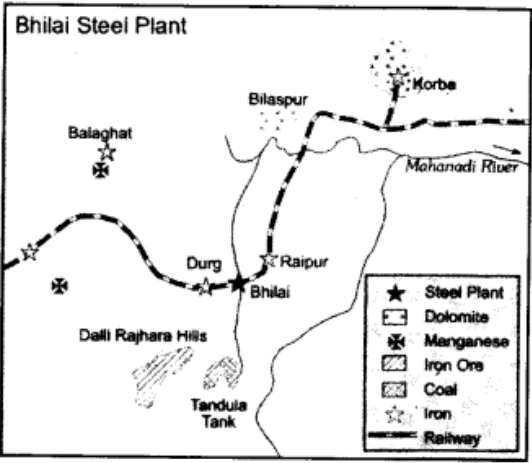
Rourkela Steel Plant
- The plant of Hindustan Steel Limited at Rourkela is situated in the Sundargarh district of Orissa It was set up with the help of the then West German firm, Krupps, and Demang, during the Second Five Year Plan (West Germany and East Germany have united to form one country now). It became operative in 1959.
- It produced 12.40 lakh tonnes of crude steel, 11.80 lakh tonnes of saleable steel, and 0.54 lakh tonnes of pig iron in 1996-97. This plant has the following facilities for its successful operation:
- This plant uses iron ore obtained from Sundargarh and Keonjhar districts. These iron ore sources are located within a distance of 77 km from the site of the plant.
- Coal is obtained from Jharia coalfields located at a distance of 225 km and Talcher, located at a distance of 169 km.
- Hydro-electric power is obtained from Hirakud Power Project, located at a distance of 150 km.
- The plant receives manganese from Barajmda, dolomite from Baradwar, and limestone from Pumapani. These materials are located within a radius of 222 km in Orissa.
- Water is provided from Sankh and South Koel rivers crossing near to it
- It is well connected to NH-6 passing south to it. It is located on the main NagpurKolkata railway line and enjoys facilities of railway transport.
- Kolkata provides port facilities and its hinterland serves as a market.
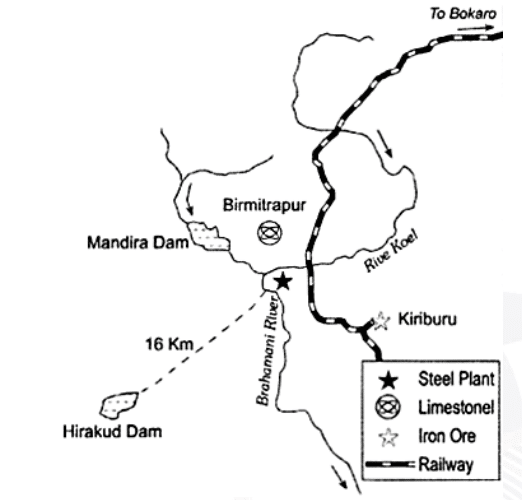
Durgapur Steel Plant
- This plant of The Hindustan Steel Ltd. is located at Durgapur in Bardhaman district of West Bengal. It was set up in 1959 with the help of the United Kingdom. The production started in 1962. It has a total capacity of 35 lakh tonnes. It produced 12.45 lakh tonnes of crude steel, 10.93 lakh tonnes of saleable steel, and 1.14 lakh tonnes of saleable pig iron in 1996-97.
- The Alloy Steel Plant at Durgapur has a capacity to produce 1.6 lakh tonnes of ingots steel which has been expanded to 2. lakh tonnes of crude steel. The following geographical factors favour its location and growth.
- Iron ore comes from Bolani mines. Mayurbhanj also supplies iron ore. These areas are located within a radius of 320 km.
- Coal comes from Jharia and Raniganj close to it.
- Limestone is obtained from Birmitrapur in Sundargarh and manganese from Keonjhar district of Orissa.
- Hydroelectricity is available from Damodar Valley Corporation.
- Plenty of water is available from Durgapur Barrage built across the Damodar River.
- NH-2 connecting Delhi with Kolkata passes through it. Lies on Kolkata-Asansol railway link connecting it to parts of the country
- Cheap labour available due to high population density
- Kolkata port close to it. Kolkata provides a rich hinterland for the market.
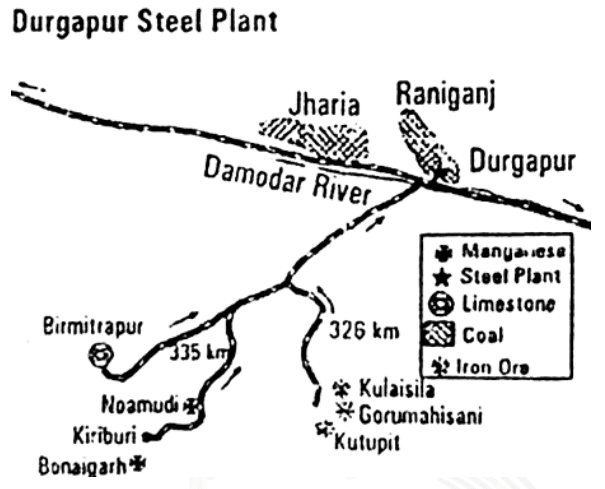
Bokaro Steel Plant
- A new public sector company, Bokaro Steel Ltd. was formed in 1964 to erect a steel plant with the collaboration of the erstwhile Soviet Union at Bokaro near the confluence of the Bokaro and Damodar rivers in Hazaribagh district of Jharkhand. It is the second plant set up with the Soviet help. It started production in 1972. Its initial capacity was 10 lakh tonnes which were raised to 40 lakh tonnes. It is the largest Indian & Steel making centre, engaged in manufacturing of rails.
- There are plans to raise its capacity to 100 lakh tonnes making it the largest iron and steel-making centre in India. It produced 36.44 lakh tonnes of crude steel, 30.46 lakh tonnes of saleable steel, and 2.6 lakh tonnes of pig iron in 1996-97. This achievement has been made possible due to the following few geographical factors:
- It receives iron ore from the Kiriburu mine in Orissa.
- Coal is obtained from Jharia coalfields located at a distance of 65 km.
- Lies on the confluence of Bokaro and Damodar rivers-water availability. Hydroelectricity is obtained from Damodar Valley Corporation.
- Kolkata is just 300 km from it, provides port facilities. NH2 (connecting Delhi and Kolkata) passes just north to it.
- Cheap labour are available from adjoining areas (tribal population).
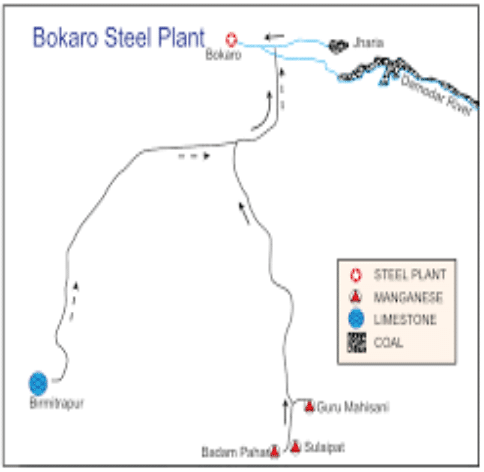
Salem Steel Plant
- The plant has been set up at Salem in the Salem district of Tamil Nadu. The plant has the advantage of rich iron ore and limestone, which is readily available in the adjoining areas. It also enjoys the facilities of cheap power, charcoal, and a vast market. The iron ore available here has low sulphur and phosphorus content and is suitable for producing special grade iron and steel.
- The Salem Steel Plant is a major producer of world-class stainless steel and is in a position to export stainless steel to some of the advanced countries such as the USA, Mexico, Australia, and some countries of South-East Asia.
- The adjoining area is rich in iron ore. This ore is converted into higher grade and then smelted in plant
- Hydroelectricity is obtained from the nearby Mettur dam.
- It is well connected to Pondicherry and Coimbatore by the highway.
- Major producer of the world-class stainless steel export to USA, Mexico, Australia and SE Asia.
- It works on the state-of-art technology and therefore not much labour is required.
Vishakapatnam Steel Plant
- This integrated steel plant has a unique location on the seaport. In fact, it is the first shore-based steel plant in the country. Although the foundation stone of the plant was laid in 1972, the construction work could not start in the real sense till February 1982 when Rashtriya Ispat Nigam Limited was incorporated as a public sector company to implement the construction of the plant.
- The plant management intends to go in for massive up-gradation of technology and the skill of its personnel which will be required if the natural gas from the Krishna-Godavari basin is to be utilized to cut down cost. The natural gas requirement is placed at one billion cubic meters (BCM) a year and negotiations are in progress with the Reliance Group in this connection. The plant has the following advantages:
- Most sophisticated technology.
- Second largest producer of iron & steel in India.
- Port location makes import and export easy.
- Major export-oriented steel plant of India.
- High-quality rich iron ore deposits are available in the Bailadila area of Chhattisgarh.
- Coal: It uses imported coke, thus relieving pressure on Indian coal mines. Also well connected to the coalfields of Damodar Valley.
- Lies on NH-5 connecting Chennai with Kolkata.
Vijaynagar Steel Plant
- This plant has been set up at Tomagal near Hospet in the Bellary district of Karnataka. It has an installed capacity of 30 lakh tonnes. The production of mild steel will be its special feature. This plant enjoys the following facilities:
- Iron ore is obtained from the Hospet region located in close proximity.
- Coal is obtained from Singarerni in Andhra Pradesh and Kanhan valley in Chhattisgarh.
- Hydroelectricity is obtained from closely located Tungabhadra dam.
Mini steel plants
- A mini steel plant is a small plant for the manufacture of steel. These plants use pig iron or scrap iron as their raw materials. These are the secondary units that use steel scrap and sponge iron as raw material and electric and induction furnaces for the processing of raw materials.
- Mini steel plants are located away from integrated plants to meet the local demands. They are mainly concentrated around urban areas.
- A large no of decentralized secondary units produce steel by using steel scrap/sponge iron as raw material and electric furnace and induction furnace for processing of raw materials.
- Mini steel plants produce mild steel, alloy steel stainless steel and are located near the market areas.
- Now the norms related to minor steel plants have been liberalized for their efficient operations.
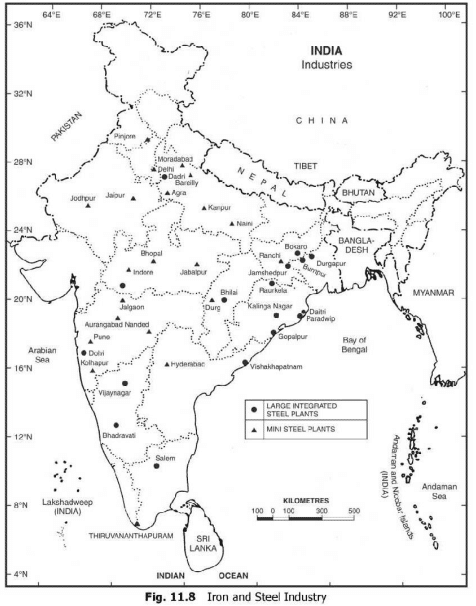
Merits of mini steel plants
- Lowest cost of establishment: Mini steel plants require less capital for their establishment as compared to larger plants.
- Short gestation period: The production process of steel in mini steel plants are shorter than that of major plants making them more time-efficient and competitive.
- Greater flexibility in operation: Mini steel plants provide greater flexibility in their operations as compared to larger plants, since the raw materials already have steel content, there is greater flexibility in operations.
- Instrumental in decentralized industrialization: Since these industries are established near urban and semi-urban areas with low capital requirements, they cover more area as compared to larger steel plants, thus contributing in balanced regional growth.
- Better position to meet local needs: Mini steel plants are well suited to meet the local demands within a short span of time such as demand from utensil setups, steel rods for construction, etc.
- Since Mini steel plants use locality available raw materials, it has contributed in the decentralization of transportation and distribution networks.
- Produces mild steel at low cost: Since the raw material involved in the production of steel contains scrap and pig iron, the cost of processing is low.
- Requires smaller infrastructure facilities: The infrastructure facilities required for steel production is very less as compared to larger units due to the nature and process involved in the production of steel.
Problem faced by mini steel plants
- Capital: Though the capital requirement is less as compared to larger plants, but still it requires large capital investment which small entrepreneurs find difficult to manage. Many plants have been established with foreign aid.
- Lack of technology: Till the 1960s and 70s, India had advanced technology from the west and the efficiency of the plants was high, but after oil crisis, there was a steep hike in energy cost and other inputs which reduced the margin of profits. Therefore, a lower level of investment was made in technological development. Except for Bokaro and Vizag, efficiency suffered in other plants.
- Low productivity: Per capita labour productivity is one of the lowest for Mini steel plants in India due to the presence of an excessively large no of labours. There is need of retraining and redeployment of labour to increase efficiency.
- Low productivity utilization -The productivity utilization rarely exceeds 80 percent due to strikes, scarcity of raw material, energy crisis, inefficient management, infrastructure bottlenecks, and political influences.
- Heavy demands: Due to increasing demand, large quantities of steel and its raw material like coal (imported from Australia) is being imported which is adversely affecting our foreign exchange reserves. It needs to be saved by increasing production to increase export.
- Blast furnace productivity is low: It is due to disharmony between the profile of resources and available technology. Indian iron one has high alumina and adverse silica-alumina ratio, while west-based technology operates well in high silica. This affects productivity. Indian coal is inferior due to its high sulphur and ash content.
- Electric arc furnaces use a large amount of power: Since in India power cost is high, they nullify the advantages of raw materials. Moreover, still we are using an outdated energy-inefficient processes like the open-hearth process.
- Indian steel is becoming expensive due to heavy taxation and high input cost.
- Increasing competition in the international market from new products like carbon fibres, composite material, reinforced plastic, etc. are also affecting the profitability of mini steel plants in India.
- Since electric arc furnaces are used, they are affected by power shortages.
- Steel scrap is imported making the plan uneconomical due to the high cost
- 75% of plants have been shut down and the prospects of up-gradation are also low. The import duty over scrap has been increased which is depleting the profitability of mini steel plants in India.
List of Steel Plants in India
| Steel Plant | Location | Operator |
|---|---|---|
| Alloy Steel Plant | Durgapur, West Bengal | SAIL |
| Bhilai Steel Plant | Bhilai, Chhattisgarh | SAIL |
| Bokaro Steel Plant | Bokaro, Jharkhand | SAIL |
| Chandrapur Ferro Alloy Plant | Chandrapur, Maharashtra | SAIL |
| Durgapur Steel Plant | Durgapur, West Bengal | SAIL |
| Essar Steel India Limited | Hazira, Gujarat | ArcelorMittal |
| IISCO Steel Plant | Asansol, West Bengal | SAIL |
| Jindal Steel and Power Limited | Raigarh, Chhattisgarh | Jindal Steel and Power |
| Jindal Steel and Power Limited | Angul, Odisha | Jindal Steel and Power |
| JSW Steel | Hospet, Bellary, Karnataka | JSW Steel |
| JSW Steel | Tarapur, Boisar, Maharashtra | JSW Steel |
| JSW Steel | Dharamtar, Maharashtra | JSW Steel |
| Rourkela Steel Plant | Rourkela, Odisha | SAIL |
| Salem Steel Plant | Salem, Tamil Nadu | SAIL |
| Tata Steel Limited | Jamshedpur, Jharkhand | Tata Steel |
| Tata Steel Limited | Kalinganagar, Odisha | Tata Steel |
| Visakhapatnam Steel Plant | Visakhapatnam, Andhra Pradesh | Rashtriya Ispat Nigam Limited |
| Visvesvaraya Iron and Steel Plant | Bhadravati, Karnataka | SAIL |
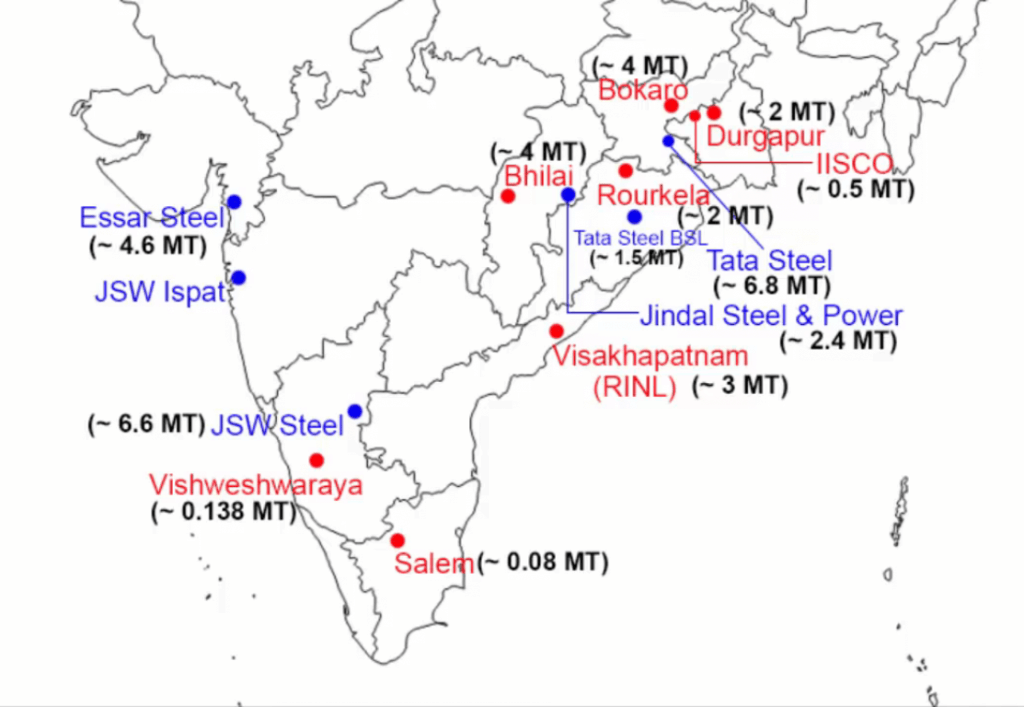
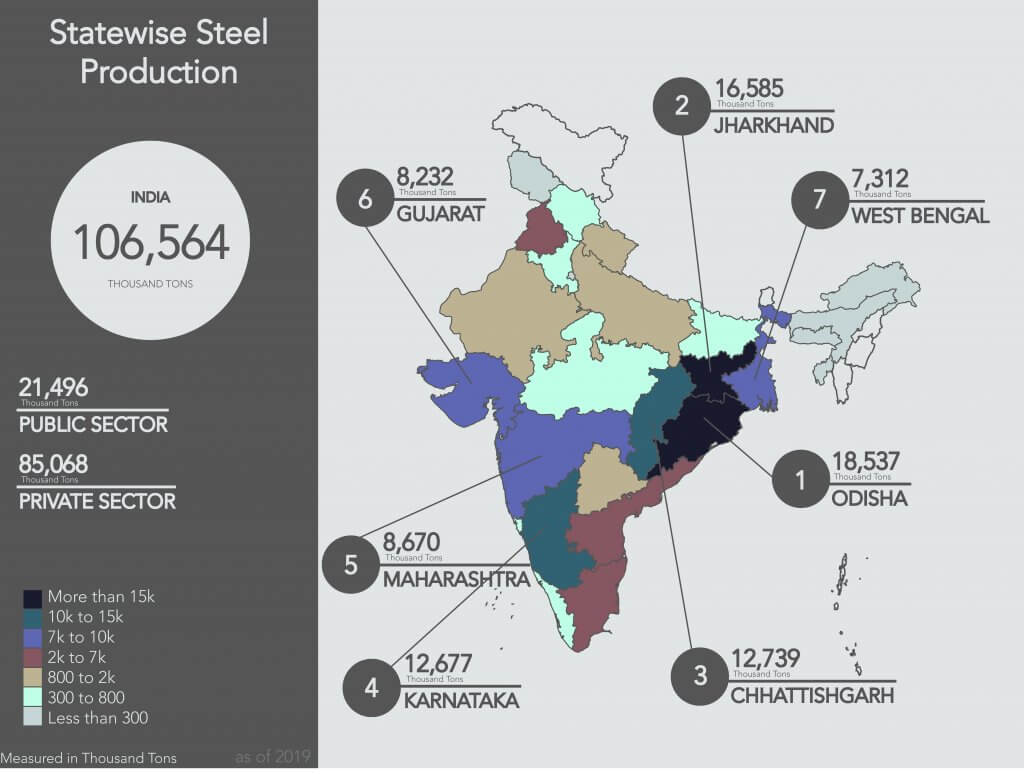
Future prospects of the steel industry
- The potential for growth of this sector is enormous. This can be gauged from the fact that the per capita consumption of steel is around 29 kg whereas the world average is 150 kg.
- Even to equal the world average, with India’s population over a billion, India will have to touch the production figure of 150 million tonnes (present consumption 29 million tonnes) in order to match the global average.
- The generation of such kind of demand is dependent on health and rate of growth of other sectors of the economy like roads, power, railway, ports, drinking water, housing and manufacturing.
New projects as an opportunity
- The government is planning to cover around 10,000 km of the existing road network for four laning. These will be good sources of new demand for steel domestically.
- As the country will need more Greenfield capacities in the coming years, the steel sector can hope to get the required impetus for steady growth.
- Track renewal plan of the railway for about 3500 km will boost the demand for steel in a major way. More high-speed trains, new demand for coaches and wagons, and building of an underground railway system will help boost the demand of steel which in term will boost the iron and steel sector.

Thanks very well composed.
thanx
What a erticle
thank you so much sir for your efforts in providing such detailed information.
Too good sir ,,,,u r helping poor students thankyou sir
Superb content.
Thank you very much
well described
very informative .thanks for publishing this kind of valuable notes